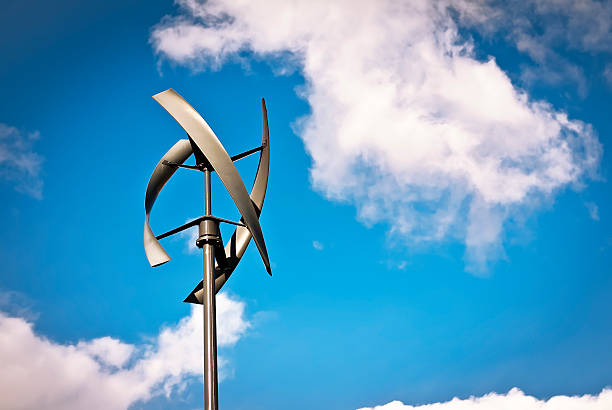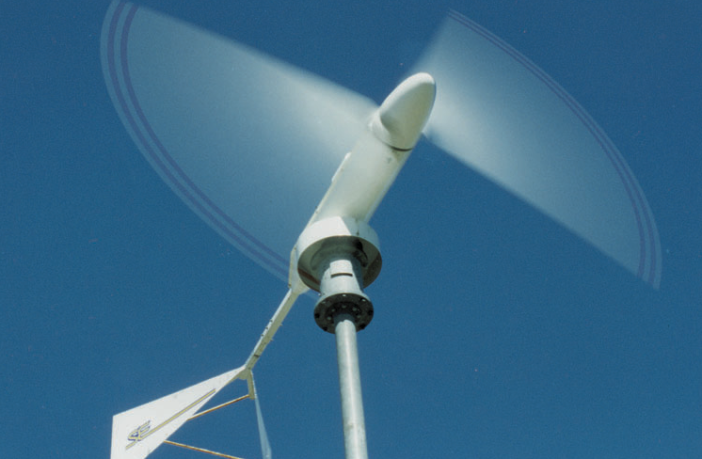Opinion
- Residential wind turbines are not common in South Africa because the historical wind data in the towns and cities in SA shows low wind speeds and wind consistency.
- The average wind speed in your area determines how much wind energy can be converted into electricity.
- This opinion piece is written for the South African context but can be applied to other countries in Africa using historical wind speed data.
Built up areas with trees tend break wind strength and consistency. Wind turbines rely on wind speed (at least 6m/s) and wind consistency for optimal performance. There are also other hinderances like high cost, noise and building height restrictions if you mount a turbine on your roof. But if the conditions are right, then wind energy can cover or offset your homes energy requirements.
Types of residential wind turbines
Horizontal-axis turbines: Horizontal-axis wind turbines are the most common type of small wind turbines. They typically feature three propeller blades that oscillate upwind, forcing the blades into the wind to maximize capture capacity. Though they’re typically heavier than their vertical-axis siblings, horizontal-axis wind turbines are better engineered for higher energy generation.

Vertical-axis wind turbine. Image credit: iStock
Vertical-axis turbines: Vertical-axis wind turbines use a rotational axis that is fixed perpendicular to the ground. These turbines are more typically reserved for residential applications but are becoming increasingly popular on an industrial scale. Vertical-axis wind turbines are designed to capture wind blowing at all angles, which makes them the more attractive option to those living in stormier climates.
Sizing Small Wind Turbines
Small wind turbines used in residential applications typically range in size from 400 watts to around 20 kilowatts. The average price for a 3.5 kilowatt wind turbine in South Africa is R150,000.00 excl VAT.
An everage 3 bed home uses around 10,000 kilowatt-hours of electricity per year (thats about 850 kilowatt-hours per month). Depending on the average wind speed in the area, a wind turbine rated in the range of 5–15 kilowatts would be required to make a significant contribution to this demand. A 1.5-kilowatt wind turbine will meet the needs of a home requiring 300 kilowatt-hours per month in a location with a 14 mile-per-hour (6.26 meters-per-second) annual average wind speed.
Checking the historical data of the average wind speed in your area HERE
A professional installer will help you determine what size turbine you’ll need plus an accurate pay back period, based on your existing electricity use. Typically your existing electricity bills will be analysed for a 12 month period because consumption may differ from season to season.
Residential wind turbines can be ground mounted or installed on your roof. The height of a wind turbine’s tower also affects how much electricity the turbine will generate. A professional installer should help you determine the tower height you will need but be aware of by laws governing building height restrictions.
Combining wind and solar power into a hybrid system – AC/DC
Much like solar PV (photovoltaics) panels produce Direct Current (DC) power which is converted to Alternating Current (AC) via an inverter, most residential wind turbines models produce also produce DC current which needs to be converted to AC (there are some models that produce AC directly). The current used in your house is AC.
If you combined the system with solar PV plus battery, you need an intelligent inverter to manage all three technologies plus grid which can get expensive. The advantage of having a wind turbine in a solar PV hybrid system is that power can be produced at night, provided there is enough wind strength during night time hours.
Install a solar geyser (hot water tank) first
My advice is to first install a solar geyser. This inititives costs less than a wind turbine or solar pv system and will reduce your electricity bill by about half and if you decide to install a wind turbine and/or a solar PV system, then you do not have to install added capacity to heat water. Changing all your light bulbs to LED’s also means extra savings on your wind turbine purchase.
If you live on a plot, farm, or remote area then a wind turbine becomes more viable and cost effective, particularly for running water pumps, but check the historical wind speed data for your area: https://www.weathersa.co.za/home/aboutclimateatsaws
Here are few links to wind turbine suppliers in SA:
I hope this info has helped you.
Author: Bryan Groenendaal












8 Comments
Got a 5Kw synsinc inverter with lithuim battery, would like to find out what wind turbine i could use with my system and how legal in residential area. My current location Jeffreys Bay, South Africa
Like the idea. What the legal requirements wrt installing a residential turbine.regards
I have a 5Kw Inverter installed. 10 Kw Lithuim battery. No panels yet and no charger yet. What do you offer.
We recommend you install solar panels if your inverter is compatible. It is highly unlikely that your inverter can manage wind power generation which is ususally in DC current.
Thank you, this was very helpful. Do you need a permit to install wind turbine?
No but the system needs to be registired with your local municipality. Your installer should be able to guide you on this process.
i have had 16 solar panels, 2 x 5.6 kv inverters and 3 lithium batteries installed, would it be beneficial to install a wind turbine, especially for recharging the batteries at night, i live in Port Elizabeth so plenty of wind.
Wind integration is complex if your inverter does not accomodate. Here is a link to important facts which must be considered when deciding to install a wind turbine in South Africa: https://www.greenbuildingafrica.co.za/viability-of-installing-a-wind-turbine-at-your-home/
I hope the info guides you well in your decision making